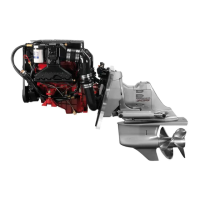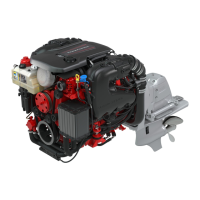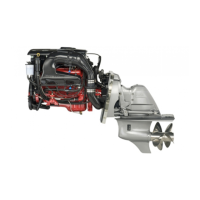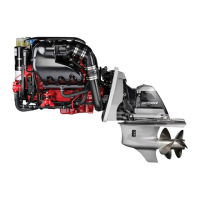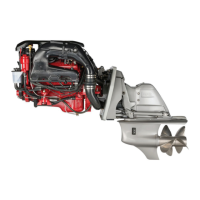Do you have a question about the Volvo Penta V6-240 and is the answer not in the manual?
Introduction to the Volvo Penta marine engine owner and the company's history.
Outlines Volvo Penta's core company values of quality, safety, and environmental responsibility.
Lists the Volvo Penta engine models covered by this operator's manual.
Describes coverage of forward drive systems in relation to the engines.
Explains the manual's content, purpose, and how to obtain additional publications.
Explains the meaning of safety alert symbols and signal words used in the manual.
Provides essential safety guidelines for operating the boat safely.
Discusses carbon monoxide hazards, symptoms, and safety measures.
Information on warranty coverage and where to find it.
Details the Volvo Penta consumer breakdown service available 24/7.
Information on Volvo Penta's worldwide network of authorized dealers.
Information about the Volvo Penta website for manuals and service.
Overview of the Electronic Vessel Control system for engine and drive.
Describes the e-Key system for engine security and starting.
Lists and describes various gauges for engine and boat monitoring.
Explains the function of the alarm indicator lamps and warnings.
Details the panel used for joystick-controlled docking operations.
Overview of available color displays (7-inch and 4-inch).
Describes customizable display views for boat, engine, and fuel data.
Guides on setting options and calibrating EVC system parameters.
Overview of Volvo Penta control configurations and features.
Special operating procedures for the first 20 hours of engine use.
How to interpret engine gauges, alarms, and warnings.
Explains the function of the boat's alarm system for engine malfunctions.
How to properly shift gears and control engine speed.
Information on the emergency stop switch and its recommended usage.
Recommended cruising speeds for optimal performance and fuel economy.
How to control the boat's trim and tilt system for optimal performance.
Detailed instructions on using the joystick for precise boat maneuvering.
Procedures for specific operating scenarios like freezing or shallow water.
Guidelines for operating a boat at high speeds safely.
Planning and reducing speed before stopping the boat at a dock or safe place.
Procedure for safely stopping the engine after operation.
Correct drive position for storage to prevent damage.
Procedure for flushing the engine with fresh water after use.
Purpose and tasks of the EVC diagnostic function for fault detection.
Types of alarms and messages that appear on displays and must be acknowledged.
Explains fault alarms as Caution, Warning, or Danger pop-ups with priorities.
Troubleshooting steps for low battery voltage.
Troubleshoots engine start failure due to high trim position.
Addresses miscellaneous engine faults and potential RPM reduction.
Troubleshoots internal faults within the EVC system.
Fault in the shift motor or position sensor, disabling shifting.
Fault for low engine oil pressure, causing reduced engine power.
Fault affecting steering and reducing engine RPM on a faulty driveline.
Procedures and precautions for when the boat runs aground.
Procedures for handling an engine that has been submerged in water.
Step-by-step guide for jump-starting a dead battery safely.
Guides to help resolve minor engine problems and ensure continued operation.
Checks for starter circuit issues when the engine does not crank.
Troubleshooting steps for cold engine starting issues.
Checks for noises and vibrations from engine components like valves and mounts.
Troubleshooting steps for an engine running rough at slow or high speeds.
Steps to address high engine temperature and potential overheating.
Addresses low oil pressure and engine knocking issues.
Factors affecting engine performance such as altitude and hull condition.
Outlines the owner's role in operating, monitoring, and maintaining the engine.
Checklists for safe boat operation and preventative maintenance.
Daily and monthly maintenance checks for the owner.
Maintenance tasks for annual service or every 100 operating hours.
Basic maintenance procedures and when to consult a dealer.
Guidance on using correct marine-grade replacement parts.
Special requirements for maintaining certified engines with emission regulations.
Inspection and service of the serpentine belt.
Information on engine lubrication, oil changes, and oil specifications.
Information regarding the high-pressure fuel system and fuel types.
Information on the engine's cooling system and impeller maintenance.
Maintenance for the ignition system, including spark plugs.
Care and replacement of the battery and battery cables.
Checking and maintaining the drive unit, including lubricant and anodes.
Information on propeller care, replacement, and safety.
Checking the power steering reservoir fluid level.
Procedures for preparing the boat and engine for storage.
Steps for short-term storage (up to two months).
Procedures for long-term storage (more than two months).
Checklist for launching the boat after short-term storage.
Checklist for launching the boat after long-term storage.
Lists the engine models covered by the manual.
Specifications for the engine's fuel system.
Specifications for the engine's electrical system.
Specifications for the engine's ignition system.
Specifications for the engine's cooling system.
Engine oil capacity specifications for V6 and V8 models.
Minimum octane rating required for gasoline fuel.
Handling and maintenance for ethanol-blended gasoline fuels.
Location of engine, transom shield, and drive identification numbers.
Statement of compliance with emission and noise regulations.
Introduction to the Volvo Penta marine engine owner and the company's history.
Outlines Volvo Penta's core company values of quality, safety, and environmental responsibility.
Lists the Volvo Penta engine models covered by this operator's manual.
Describes coverage of forward drive systems in relation to the engines.
Explains the manual's content, purpose, and how to obtain additional publications.
Explains the meaning of safety alert symbols and signal words used in the manual.
Provides essential safety guidelines for operating the boat safely.
Discusses carbon monoxide hazards, symptoms, and safety measures.
Information on warranty coverage and where to find it.
Details the Volvo Penta consumer breakdown service available 24/7.
Information on Volvo Penta's worldwide network of authorized dealers.
Information about the Volvo Penta website for manuals and service.
Overview of the Electronic Vessel Control system for engine and drive.
Describes the e-Key system for engine security and starting.
Lists and describes various gauges for engine and boat monitoring.
Explains the function of the alarm indicator lamps and warnings.
Details the panel used for joystick-controlled docking operations.
Overview of available color displays (7-inch and 4-inch).
Describes customizable display views for boat, engine, and fuel data.
Guides on setting options and calibrating EVC system parameters.
Overview of Volvo Penta control configurations and features.
Special operating procedures for the first 20 hours of engine use.
How to interpret engine gauges, alarms, and warnings.
Explains the function of the boat's alarm system for engine malfunctions.
How to properly shift gears and control engine speed.
Information on the emergency stop switch and its recommended usage.
Recommended cruising speeds for optimal performance and fuel economy.
How to control the boat's trim and tilt system for optimal performance.
Detailed instructions on using the joystick for precise boat maneuvering.
Procedures for specific operating scenarios like freezing or shallow water.
Guidelines for operating a boat at high speeds safely.
Planning and reducing speed before stopping the boat at a dock or safe place.
Procedure for safely stopping the engine after operation.
Correct drive position for storage to prevent damage.
Procedure for flushing the engine with fresh water after use.
Purpose and tasks of the EVC diagnostic function for fault detection.
Types of alarms and messages that appear on displays and must be acknowledged.
Explains fault alarms as Caution, Warning, or Danger pop-ups with priorities.
Troubleshooting steps for low battery voltage.
Troubleshoots engine start failure due to high trim position.
Addresses miscellaneous engine faults and potential RPM reduction.
Troubleshoots internal faults within the EVC system.
Fault in the shift motor or position sensor, disabling shifting.
Fault for low engine oil pressure, causing reduced engine power.
Fault affecting steering and reducing engine RPM on a faulty driveline.
Procedures and precautions for when the boat runs aground.
Procedures for handling an engine that has been submerged in water.
Step-by-step guide for jump-starting a dead battery safely.
Guides to help resolve minor engine problems and ensure continued operation.
Checks for starter circuit issues when the engine does not crank.
Troubleshooting steps for cold engine starting issues.
Checks for noises and vibrations from engine components like valves and mounts.
Troubleshooting steps for an engine running rough at slow or high speeds.
Steps to address high engine temperature and potential overheating.
Addresses low oil pressure and engine knocking issues.
Factors affecting engine performance such as altitude and hull condition.
Outlines the owner's role in operating, monitoring, and maintaining the engine.
Checklists for safe boat operation and preventative maintenance.
Daily and monthly maintenance checks for the owner.
Maintenance tasks for annual service or every 100 operating hours.
Basic maintenance procedures and when to consult a dealer.
Guidance on using correct marine-grade replacement parts.
Special requirements for maintaining certified engines with emission regulations.
Inspection and service of the serpentine belt.
Information on engine lubrication, oil changes, and oil specifications.
Information regarding the high-pressure fuel system and fuel types.
Information on the engine's cooling system and impeller maintenance.
Maintenance for the ignition system, including spark plugs.
Care and replacement of the battery and battery cables.
Checking and maintaining the drive unit, including lubricant and anodes.
Information on propeller care, replacement, and safety.
Checking the power steering reservoir fluid level.
Procedures for preparing the boat and engine for storage.
Steps for short-term storage (up to two months).
Procedures for long-term storage (more than two months).
Checklist for launching the boat after short-term storage.
Checklist for launching the boat after long-term storage.
Lists the engine models covered by the manual.
Specifications for the engine's fuel system.
Specifications for the engine's electrical system.
Specifications for the engine's ignition system.
Specifications for the engine's cooling system.
Engine oil capacity specifications for V6 and V8 models.
Minimum octane rating required for gasoline fuel.
Handling and maintenance for ethanol-blended gasoline fuels.
Location of engine, transom shield, and drive identification numbers.
Statement of compliance with emission and noise regulations.
| Engine Type | V6 |
|---|---|
| Power Output | 240 HP |
| Fuel Type | Gasoline |
| Fuel System | Multi-port fuel injection |
| Compression Ratio | 9.4:1 |
| Displacement | 4.3 L |
| Alternator | 65 A |
| Cooling System | Closed-loop cooling |
